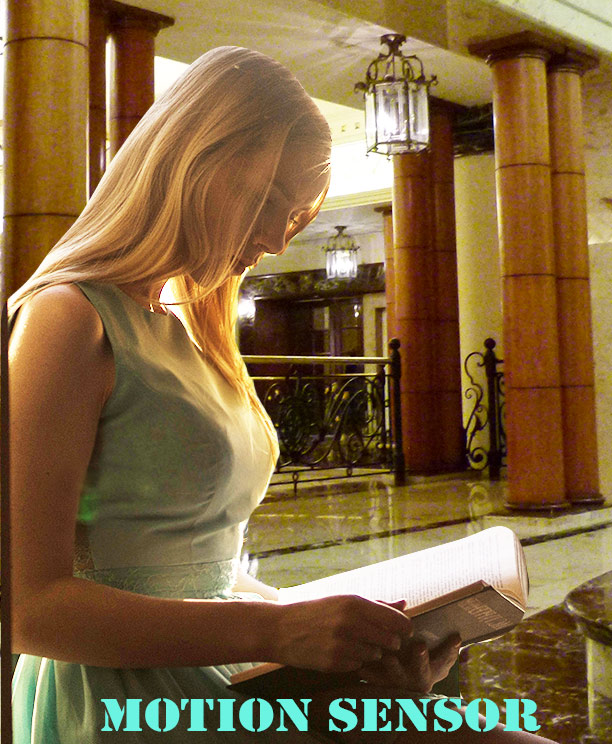Motion sensors are small electronic devices which detect the presence of humans primarily. These devices are used to control doors, turn on lights and alarms.
Motions sensors save a pile of energy and tons of Carbon dioxide. A real world example would tell us how: Typically an outdoor light consumes anywhere between 30 W and 1000 W depending upon the type. If you use a conventional incandescent bulb, you need a flood light of 1000 W to illuminate a long drive way. Over a year of normal usage, it will consume 4320 kWh at a cost of 648 US dollars (assuming 15 cents per kWh and daily 12 hours of usage) and about 3.4 tons of co2 emission. Now if you use a motion sensor to control the light, it will consume 720 kWh at a cost of 108 US dollars and 0.5 ton of co2 emission.
You can use a LED flood light of 30 W to provide similar light output with drastic drop in power consumption.

Motion Sensing Switches:
Types of Motion Sensors: Motion sensors are of 2 types: PIR and RADAR (microwave). PIR (Passive Infrared) sensors work by detecting the infrared energy emanating from humans and control the light. It uses a Fresnel lens to focus the energy into the sensor. Switches fitted with PIR sensors work well under most situations. But they have a draw back – the sensitivity of detecting people drops with the rise in ambient temperature. In other words, you will have to flail your arms to trigger the PIR switch in summer where the ambient temperature rises. Another drawback of PIR motion sensor is if the object sensed remains motionless, the PIR switch may turn off.
The RADAR (microwave) sensors work with microwave frequencies – 5.8 GHz to 24 GHz which can detect motion even through wooden doors, glass and light partitions. And they are not temperature sensitive like their PIR counterparts. If you are worried about the microwave radiation, you don’t need to worry. They output less than 1 milliWatt continuously. Compare this with your smartphone which can output 100 mW. Your microwave oven puts out more than 650 W of microwave energy within its shell.
A high end RADAR sensor device operating at 24 GHz has increased detection range, reduced false alarms and better detection of humans and large mammals. Besides the technical advantages, RADAR sensors also can be hidden behind surfaces unlike the PIR sensors which depend on a visible round Fresnel lens to detect.
These Motion sensor Switches also contain light sensors built-in so that they are not turned on during the day time. So these devices can be permanently left on. In quiescent mode (when the lights are not on) they consume low power: 0.2 – 0.9 W
Comparison of PIR and RADAR motion sensor Switch
| Details | PIR | RADAR |
| Temperature sensitivity | Range drops with increase in ambient temperature | No comparable temperature sensitivity |
| Appearance | Needs to use obvious Fresnel lens | Device has no obvious tell-tale lens |
| Range and obstacles | Limited range. Line of sight capture range. Angle is 110 degrees | Extended range. Angle is 260 degrees typical. Works against thin wooden doors, glass etc |
| Detection capability | Horizontally Moving targets at ideal minimum speed. | Wider capture range. Detects animals at least 1 feet tall. Better differentiation between humans and animals. Lesser false triggering |
Tips on using Motion sensors:
Position: The position of the Motion detector /Occupancy sensor is critical to the effective operation of these devices. Generally, if you want maximum range and fewer false triggering, place the sensors between 7 and 9 feet. If it is a PIR sensor, place them away from heat sources and hot air draught. Position these sensors in such a way that the target has the maximum distance to cover. The PIR Fresnel lens should be clear all the time. Dust and atmospheric pollutants can coat the surface of the lens rendering it ineffective over a period of time.
It is essential that these motion sensor devices are kept clean depending upon the environment in which they are operated.
Another thing to note is if the sensor is self-contained inside a LED bulb, do NOT place that bulb in a completely closed lamp fitting. Despite the fact that LED bulbs draw significantly lower power compared with their incandescent counterparts, their drivers use electronics to step down the mains voltage to the right level for the LED chips to work. And the electronics can produce quite a bit of heat. If you use a closed lamp fitting and the weather is sufficiently warm, it can easily destroy the sensitive electronics driver. Most LED bulbs fail because of heat.
